ISSN ONLINE(2319-8753)PRINT(2347-6710)
ISSN ONLINE(2319-8753)PRINT(2347-6710)
| Sevvel P and Santhosh P Mechanical Department, Magna college of Engineering, Magaral, Chennai, India |
| Related article at Pubmed, Scholar Google |
Visit for more related articles at International Journal of Innovative Research in Science, Engineering and Technology
This paper provides the complete information and the reasons for the low power extraction from the wind by the wind turbines. The opposing wind forces are completely neglected with the help of a deflector such that the speed of the turbine shaft is increased faster than normal, even at very low wind speed (1m/s). Almost all the wind turbines extract only 50 to 60% of total wind power due to low speed. This is due to the wind resistance in the blades. Wind turbines are generally located at a higher altitude nearly 100 feet above the ground level in order to acquire a large wind power. The main objective of our project is to increase the speed of the rotor shaft even at low speed of wind (1 m/s), using a modified design in order to increase the power production.
Keywords |
| Cut-in speed, Cut-out speed, Wind Power, Power curve, Generator capacity. |
INTRODUCTION |
| The Windmill extracts energy from moving air by slowing down the wind, and transferring this harvested energy into a spinning shaft, which usually turns an alternator or generator to produce electricity. Wind energy is a renewable power source which generated from wind current flowing across the earth's atmosphere. This energy can be used for quenching the energy thirst of the world. Wind energy is one among the fastest growing sources of alternate power generation in the world today. |
| • Green Power: The energy produced from wind is clean because generation procedures have no effect on atmosphere hence no pollution or greenhouse gases. |
| • Sustainable: Wind energy is a self sustained resource and present abundant in nature. This infinite energy makes the investors to make a stable investment for our energy demand as well as for our future generation. |
| • Affordable: Wind power is a cheap and can be extracted largely with the help of technological advancements. Hence these machines are manufactured in large scale. |
TYPES OF WIND TURBINE |
| Wind mill is of many types, among them two is most widely used and common one. |
| They are |
| • Vertical axis wind turbine |
| • Horizontal axis wind turbine |
| A. Power Spots |
| The power available in the wind that can be harvested depends on two factors i.e. wind speed and the area swept by the propeller blades. |
| B. Objective |
| The main objective of our project is to increase the speed of the rotor even at low speed of wind in vertical axis wind turbine. |
NEED |
| Every year, wind produces only a small amount of the electricity to country, but the usage of electricity is growing every year. One reason wind farms don’t produce more electricity is that they can only run when the wind is blowing at certain speeds. In Tamil Nadu power cut is most common nowadays, many villages experience about 16 hours power cut. In Coimbatore about 40000 small scale industries losing 1500 cores a month due to frequent power cut. |
RESEARCHERS SUGGESTION |
| China Aerodynamics Research and Development Centre (CARDC) on the small-sized Horizontal axis wind turbine, the starting wind speed is usually in the range of 4~5 m/s, and the maximum has been up to 5.9 m/s. this starting performance obviously can't be satisfactory. Whereas Vertical Axis wind turbine can start at a wind speed of 2m/s, which is undoubtedly preferable than the Horizontal axis wind turbine. |
| A. Existing statistics |
| Almost all the wind turbines extract only 50 to 60% of total wind power. This is due to the wind resistance in the blades. In order to find where the 40% power loss occurs, we researched and found the reason after a few prototypes. |
| Consider a wind flowing in a particular direction such that the vertical axis wind turbine starts rotates the shaft in clockwise. There is an opposing wind forces acted on the other side of the blades which slows down the speed of the rotation of the shaft. |
| Hence we placed a deflector such that there is no opposing wind forces to hinder the rotation of the shaft. |
| With some additional design feature the wind flow is directly concentrated on the turbine blades to increase the speed of rotation. |
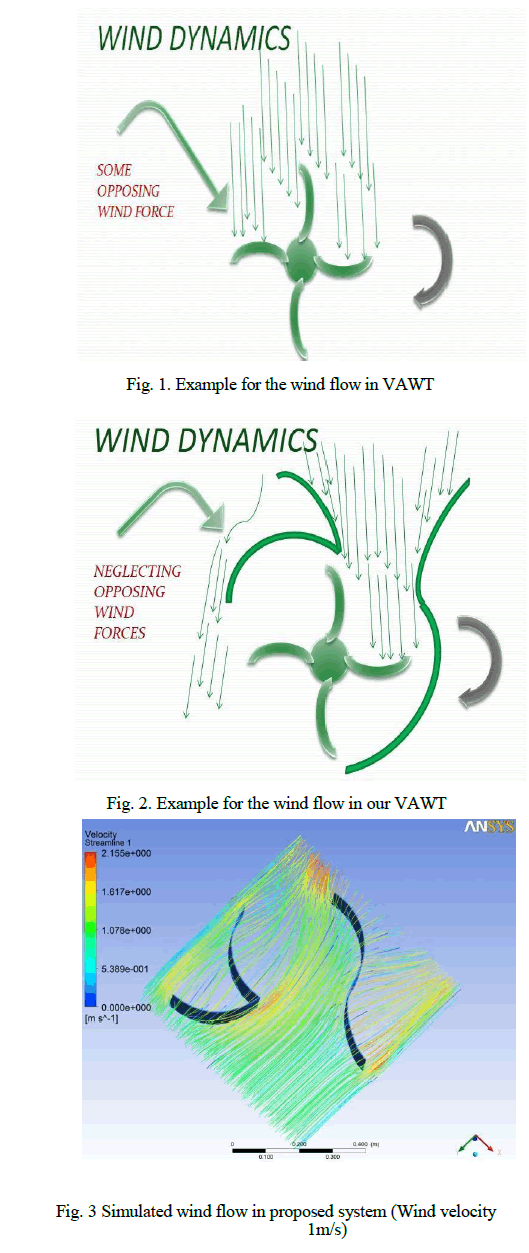 |
| The opposing wind force that hinders the rotation of the shaft is neglected with the help of the deflector which alters the path of the wind flow. |
| The Fig.3. Shows the simulated image of the crosssection where the wind flows at a velocity of 1m/s laminar flow in Ansys workbench software. |
MODIFICATIONS |
| Some of the modification which is done to increase the velocity of the wind are as follows |
| • Nozzle |
| • Deflector |
| • Guide |
| • Ventilation |
| • Steering tail |
| A. Nozzle |
| Nozzle is a device which converts low velocity fluid at inlet into high velocity fluid at exit. |
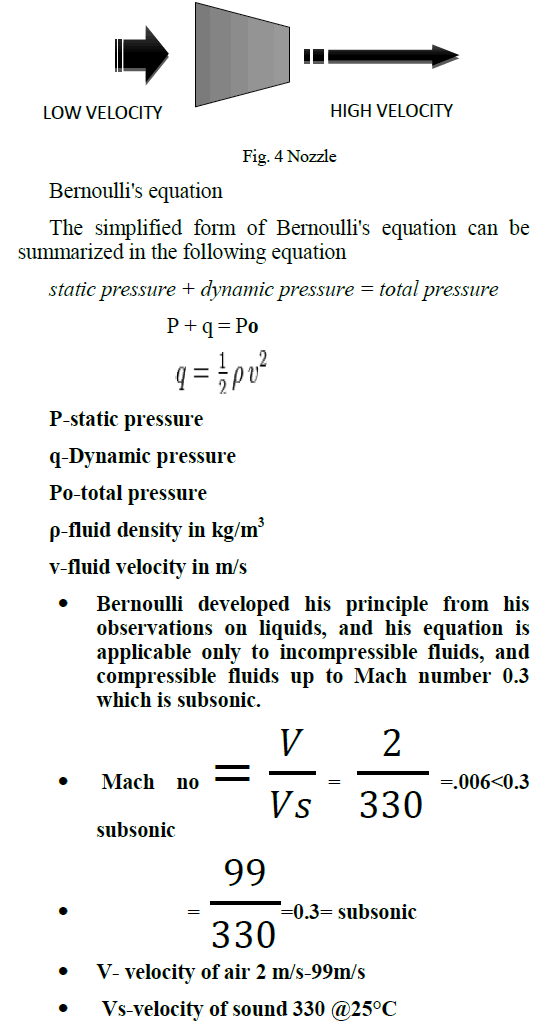 |
| B. Deflector |
| It neglects the opposing wind forces and deflects the wind. |
| C. Guide |
| It guides the wind to flow in a circular path and to rotate the blade. |
| D. Ventilation |
| Ventilation is necessary for every air flowing object hence we place ventilation in order to ensure the air flow is continuous. |
| E. Steering tail |
| It is used to turn the total modification to the direction in which the wind flows |
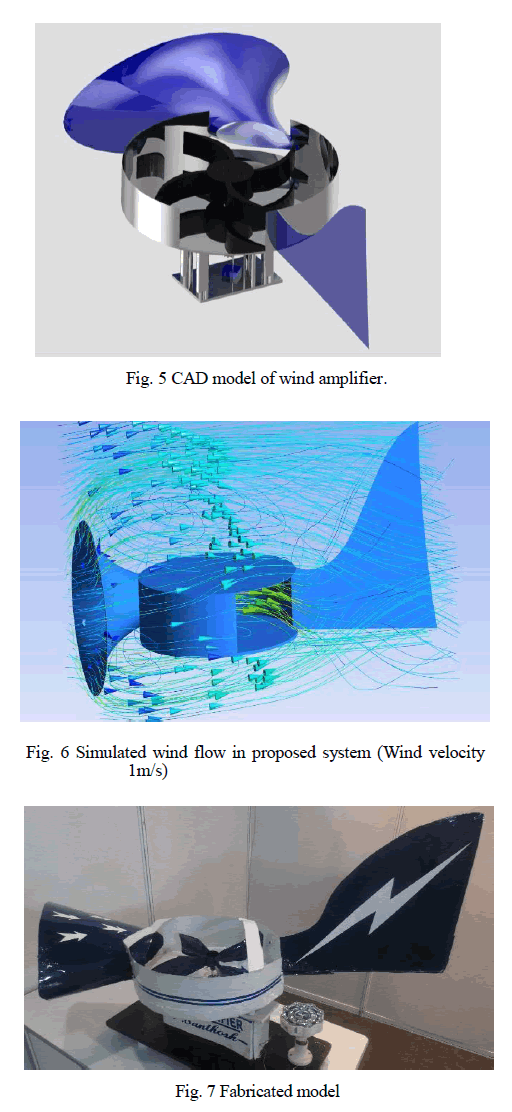 |
CHARACTERISTICS |
| A. Power curve |
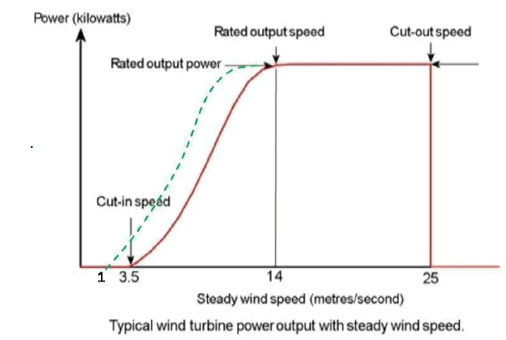 |
| The above graph shows the power variation of a wind turbine at various wind speed. |
| B. Cut-in speed: |
| A wind turbine generally requires a minimum torque to rotate its shaft but at a low wind speed it fails to rotate. Simultaneously when the wind speed is increased the rotor starts to rotate and produce electricity. The minimum wind speed which is required to start generating electricity is said to be cutin speed normally the cut in speed ranges from (3-5 m/s).but the proposed system requires only low (1m/s) wind velocity. |
| C. Up to Generator capacity: |
| When the wind speed is increased the power produced is increased simultaneously. The power produced will remain constant at a particular point when reaching the generator capacity. The maximum power delivered by the generator is said to be the rated power .generator is one of the main factor in the power generation which is designed in such a way that it can produce electric ity at a particular speed. |
| D. Cut-out speed: |
| When the speed of the wind turbine increase tremendously it results in damage to the rotor at a particular point. Hence a braking system has to be adopted in the system to stop the rotor at this situation. This is said to be cut-out speed normally the cut in speed ranges from (25 m/s). |
WIND TURBINE EFFICIENCY |
| Kinetic Energy of wind is, |
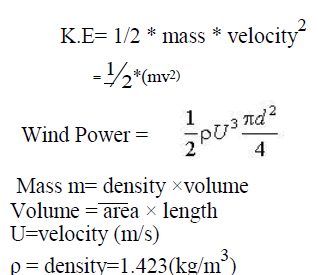 |
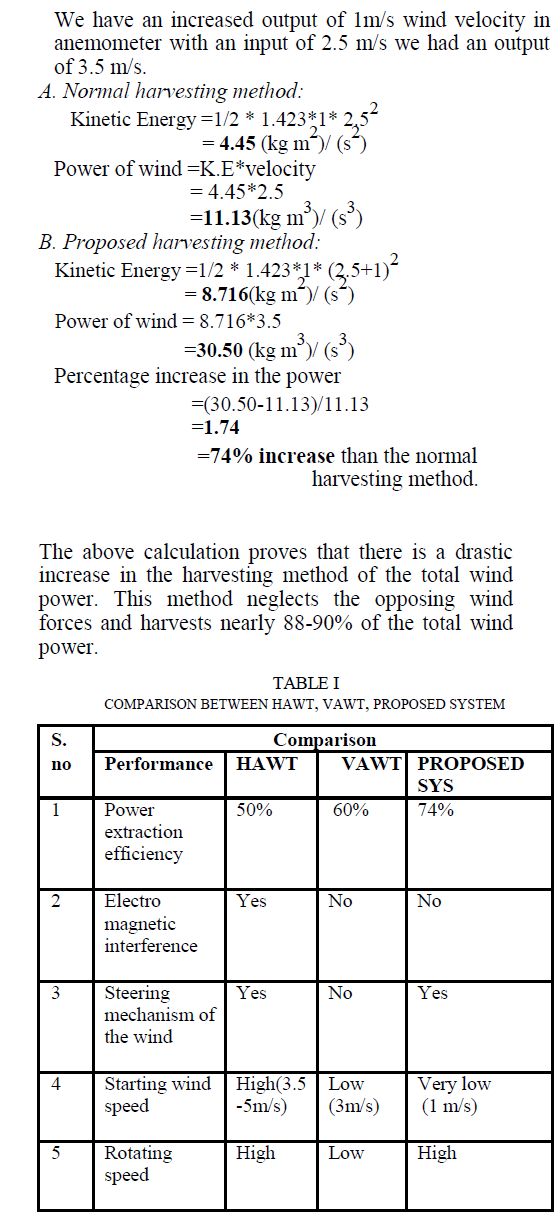 |
ADVANTAGES |
| • High power delivery |
| • Easy installation |
| • Cheap |
| • Suitable even at low wind areas |
| • Compact structure |
| • Simple |
| • Self-sustaining energy |
DISADVANTAGES |
| Auto aligning (steering mechanism) is not rapid which can be replaced by auto rotor systems. |
References |
|